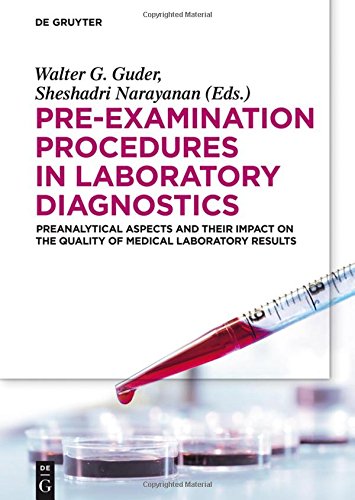

Most ebook files are in PDF format, so you can easily read them using various software such as Foxit Reader or directly on the Google Chrome browser.
Some ebook files are released by publishers in other formats such as .awz, .mobi, .epub, .fb2, etc. You may need to install specific software to read these formats on mobile/PC, such as Calibre.
Please read the tutorial at this link. https://ebooknice.com/page/post?id=faq
We offer FREE conversion to the popular formats you request; however, this may take some time. Therefore, right after payment, please email us, and we will try to provide the service as quickly as possible.
For some exceptional file formats or broken links (if any), please refrain from opening any disputes. Instead, email us first, and we will try to assist within a maximum of 6 hours.
EbookNice Team

Status:
Available4.6
8 reviews
ISBN 10: 3110331659
ISBN 13: 9783110331653
Author: Walter G Guder, Sheshadri Narayanan
The preanalytical phase is an important component of Laboratory medicine and errors arising in this phase affect the validity of laboratory results. In this book physicians and clinical staff have access to valuable information about the current preanalytical variables and factors (patient preparation, sample collection, handling and processing before analysis).
1 General Part
1.1 Introduction and History of the Preanalytical Phase
1.2 Requesting Laboratory Tests: Benefits and Limitations of Laboratory Diagnostic Pathways
1.3 Definition of the Influence and Interference Factors in the Preanalytical Phase
1.4 Extraanalytical Procedures and their Management in Total Turnaround Time
2 Types of Samples and Anatomic Site of Origin
2.1 Arterial, Venous or Capillary Blood ?
2.2 Special Pre-Examination Conditions in Newborns and Pediatric Patients
2.3 Venous Blood Sampling (Phlebotomy)
2.4 Arterial Sampling of Blood
2.5 Capillary Sampling of Blood
2.6 Plasma or Serum? Which Anticoagulant to Use?
2.7 Spot or Timed Urine – Preanalytical Aspects of Urinalysis
2.8 When are other Body Fluids to be Analyzed?
2.9 Who is Doing Phlebotomy in Europe?
3 Biological Variables Influencing Laboratory Results
3.1 Age and Gender Differences – Unavoidable Influences on Laboratory Results
3.2 Variables during Sampling
3.3 Food, Drinks and Smoking
3.4 Effect of Herbs
4 Source and Nature of Interferences of Analytical Procedures
4.1 The Hemolytic Sample
4.2 The Lipemic Sample
4.3 The Icteric Sample
4.4 Drug Interferences
4.5 Interferences from Blood Sampling Device Materials on Clinical Assays: I Blood Collection Devices and Their Constituents and Additives
4.6 Influences and Interferences from Blood Sampling Device Materials on Clinical Assays: II Special Devices and Procedures; Recommendations
5 Sampling Materials and Techniques
5.1 Materials and Techniques of Sampling Blood and other Body Fluids. Contributions of Greiner – Bio One
5.2 Materials and Techniques of Sampling Blood by Sarstedt
5.3 BD Preanalytical Systems – Diagnostic Sample Collection
6 Specimen Processing in the Preanalytical Phase
6.1 Sample Transport, Treatment after Arrival, Storage and Disposal
6.2 Preanalytical Workflow Techniques and Procedures
7 Preanalytical Variables and Rules in Specific Fields of Medical Laboratory Diagnostics
7.1 Hemostaseology
7.2 Hematology including Flow Cytometry of Blood Cells
7.3 Blood Gases, Ions and Electrolytes
7.4 Clinical Chemistry including Metabolites, Enzymes, Hormones and Proteins
7.5 Preanalytical Variables in Therapeutic Drug Monitoring
7.6 Preanalytical Variables in Microbiology
7.7 Biobanking
8 Quality Assurance and Auditing of the Preanalytical Phase
8.1 Auditing of the Preanalytical Phase
8.2 Internal Quality Assurance for Preanalytical Phase
8.3 External Quality Assurance for the Preanalytical Phase
9 Annex: Samples and Stability of Analytes
examination procedures
z procedure codes
exam procedures review service
antenatal examination procedure ppt
eye examination procedure pdf
Tags: Walter G Guder, Sheshadri Narayanan, Examination, Procedures